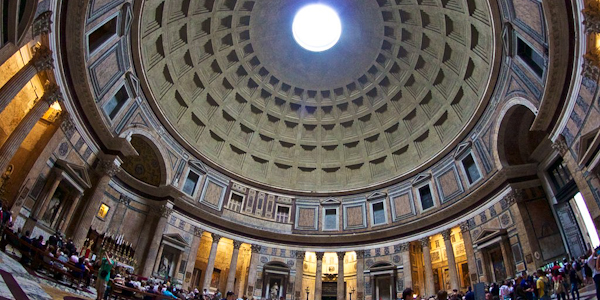
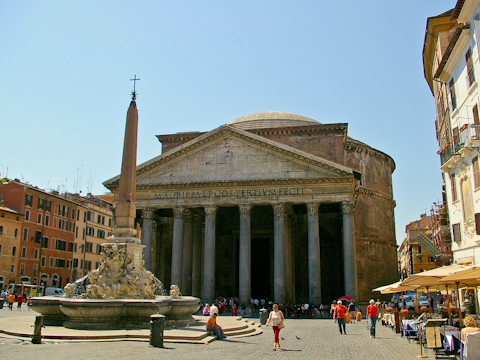
"Simple, erect, severe, austere, sublime" is the list Byron made when his poet's pen began failing for words to capture the indescribable beauty of the Pantheon, a "temple to all the gods."
The only ancient Roman temple to survive the centuries intact is one of the engineering marvels of the ancient world.
It was designed in AD 118–125 by none other than Emperor Hadrian himself, who was quite the brilliant architect, and the genius of how its enormous concrete dome manages to hold up under its own weight remained a mystery until the masters of the Renaissance unlocked its secrets over 1,300 years later.
Stand in front of it on the piazza for a moment before you go in. Or maybe sit on the steps of Giacomo Della Porta's 1578 fountain with the ugly, pug-nosed fishes spewing water beneath an obelisk from Ramses II's time (this used to sit in a nearby temple to Isis, the Egyptian river goddess).
Before you is a massive and obviously ancient colonnade, with the uninspired comment "Marcus Agrippa, son of Lucius, Consul for the third time, made this" inscribed in abbreviated Latin on the architrave. This chunk o' weathered history seems in better repair than most of the crumbling remains of the Caesars' Rome, but other than that, it d oesn't seem to be much.
Yet.
Save it for a moment. Get suitably impressed by passing through the small forest of massive granite columns supporting the portico's roof (in case you were wondering, they're about 44 feet high, and the pinkish ones are replacements for a few that got plundered by Popes).
The holes in some of the columns were made to hold wooden poles back when this magnificent porch was filled with poultry stalls. (The piazza out front was a fresh fish market. The smell must have been horrendous, but I must admit that Romans made good use of available space while the Popes were away in Avignon in the late Middle Ages).
Now squeeze through that open left hand bronze door (almost 2,000 years old, made of solid bronze, and weighing 20 tons—as does the other door, so don't even try to push it open yourself). Slip past the little souvenir stand just inside and let your eyes be drawn up.
You may gape now.

There are a lot of other details to the Pantheon—measurements and dates and famous burials and infamous deeds—but at the moment you walk in they don't mean much. They don't even come close to summing up the airy, massive, and beautifully simple space filled with diffused sunlight that is the real wonder of the Pantheon.
Lose your gaze in the unfocused middle space for a while and enjoy it.
For the detail obsessed, I'll toss in a few of those facts for you to peruse while your friends undergo their mystical/religious experience and get tremendous cricks in their necks.
Those with an bit of Greek in their system will be able to figure that the name pantheon means "all the gods," and that is what Marcus Agrippa, general and son-in-law of Augustus Caesar, built on this spot in 27 BC.
That little, square temple burned a couple of times, and around AD 120, the traveling, intellectual, architecturally-inclined Emperor Hadrian cleared the ground and built a bigger, better, and much longer-lasting Pantheon of his own design in its place. Out of modesty—or an ostentatious display of modesty—Hadrian added the inscription about Agrippa outside, humbly giving him credit for the whole thing.
My own guess is that, whatever his other virtues, Hadrian was being the consummate showman when he added the inscription. The bulk of the temple's cylinder is hard enough to notice today from the front, but back in toga-times the whole building was five steps above ground level, so when you approached it, you wouldn't have seen the body of the temple at all. Just the portico.
I think Hadrian just wanted to add to the breath-catching, awe-inspiring experience of walking up to what appears to be just the small square temple of Agrippa, but then passing through the doors into a room that you would swear up and down could not possibly fit into that space.
Part of what makes the space so perfect is the harmony of its math.
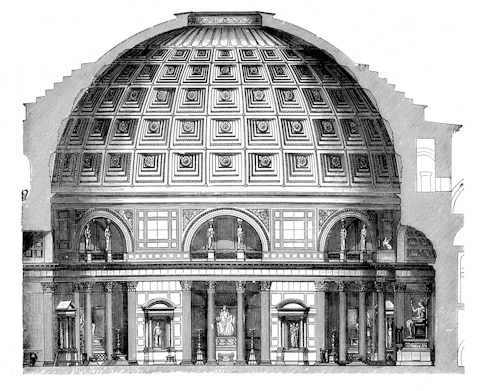
The Pantheon is as tall as it is wide (142 feet both ways), and the coffered dome is a perfect half-sphere starting halfway up the wall. In other words, a 142-diameter sphere, if you could find one, would fit inside just perfectly.
That big hole in the ceiling though which a shaft of sunlight streams is called an oculus, and it is 18 meters (almost 30 feet) across. The walls are nearly 25 feet thick and the whole structure is made of brick and graded concrete (a Roman invention).
Yes, all that concrete in the dome is rather heavy—and it's wearing a lead yarmulke to boot—but don't worry. The stone in the concrete is ultra-light pumice, its gets thinner and lighter as it approaches the top, and the weight—rather than bearing down—is cunningly distributed by brick arches embedded sideways in the walls and channeled into a ring of tension around the lip of that oculus that actually helps support the whole thing.
It remained the largest dome in the world until Brunelleschi built the Duomo in Florence 1,200 years later. Michelangelo had a bit more reverential respect for the structure, and he purposefully designed his dome in St. Peter's to be one meter smaller.
Whenever it starts raining and I'm in central Rome, I start running—not for shelter, but for the Pantheon.
There you can watch the raindrops floating down from the gaping oculus in the Pantheon's dome, splattering against the worn marble flooring, and slipping through the drain on the floor.
On the rare occasions when it snows, the effect is downright mystical.
The Pantheon has survived the ages partly because it was left alone by the barbarians, who normally looted and burned Roman temples on their frequent maurading and sacking binges throughout the Dark Ages, but found the Pantheon just too darn pretty to destroy.
But there's another reason it survived, virtually intact, the later destruction of almost all pagan temples by the often overly-zealous medeival Church, the languishing years of a backwater Rome without the papacy (but when everybody had plenty of fresh fish and chickens), later Baroque fits of interior refurbishing, and even the Fascist years when Mussolini aggrandized anything could he could lay his hands on to try and connect himself with the glory of ancient Rome.
The early Christian Church decided to add one more god into the temple's pantheonic mix.
In 609, the Byzantine Emperor Phocas gave the pagan temple to Pope Boniface IV, who slapped a Catholic altar in it and christened it Santa Maria ad Martyres, which is to say St. Mary and all the martyrs. Martyrs, you may have noticed, have a tendency to become saints, and as the new (or rather, recycled) church's dedication took place on November 1, this became known as All Saints Day. From all the gods to all the saints—the consecration of the Pantheon as a Christian church really just changed the semantics, not the meaning.
Not all Christians, however, were that charitable to the venerable old structure.
The roof originally shined with gilded bronze, but Byzantine Emperor Constans II decided these tiles would serve the Empire better me lted down for his treasury. In the 8th Century, Pope Gregory III relined roof with lead plates, but it wasn't quite the same effect. I don't know why he was too cheap to spring for the bronze.
But the one insult Italians will never forget or forgive was when the 18th century Barberini Pope Urban VIII removed the bronze revetments from the portico's ceiling and melted them down to make Bernini's baldacchino in St. Peter's and (even worse) some canons for his private fortress, Castel Sant'Angelo. The nearby Pasquino statue—a kind of anonymous, pithy political commentator to which Renaissance Romans would attach plaques bearing their witty epithets and quips against the government—was quick to comment: "Quod non fecerunt Barberi, fecerunt Barberini," ("What even the barbarians wouldn't do, Barberini did.")
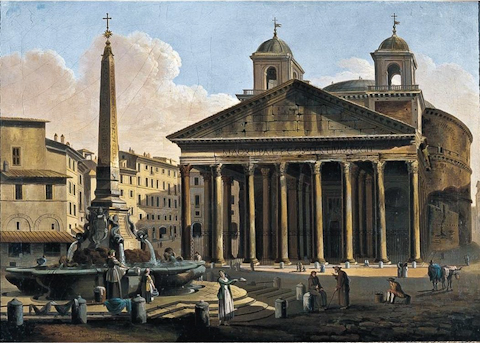
Urban VIII, perhaps acting on some bad conciliatory advice from his political spin doctors, then had Bernini add two squat turrets to either side of the pediment, eyesores which Pasquino quickly dubbed "Bernini's ass's ears." They stand as quite possibly the only widely reviled work Bernini ever produced, and were thankfully cropped off in 1883.
In a centuries-long example of recycling, some of those very same bronze canons from Castel Sant'Angelo were melted down yet again to make ornaments for the tomb of Italy's first king, Vittorio Emmanuele II—which is, of course, inside the Pantheon. It was poetic justice. Very pointedly political and intentional, but justice just the same.
Head to the right as you enter to admire briefly those much-maligned bronze of the ornaments on Vittorio Emmanuele II's tomb. He was the first king of the unified Italy, to whom the horrendously ugly pile of white marble squatting in Piazza Venezia is dedicated. He died in 1878, just nine years after finally having conquered Rome and completing his new kingdom.
His son, King Umberto I—a staunch conservative with an impressivly bushy moustache who was assasinated by anarchists in 1900—is entombed on the opposite side of the church. Under Umberto is a third royal tomb, that of Umberto's wife Queen Margherita of Savoy, who may be indirectly responsible for the invention of what we now call "plain pizza."
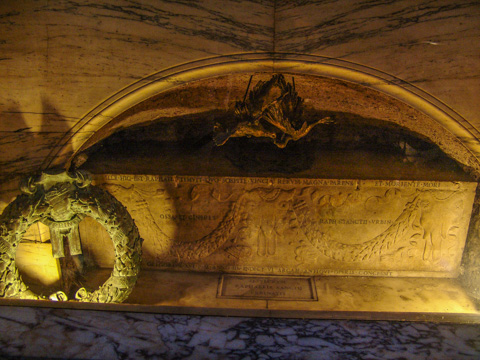
But perhaps the most important tomb for those not into 19th-century royal families lies in a niche between the second and third chapels on the left. The earthly remains of Rafaello Sanzio d'Urbino lie in that smallish yellow stone box, know to the world as Raphael, one of the Renaissance's greatest artists.
When Raphael died at the young age of 37, the entire city joined in his funeral procession through the streets, carrying with them the enormous and vibrant unfinished work they found in his studio, the Transfiguration (it now hangs in the Vatican Museums Pinacoteca).
When they lay him to rest in this church, they hung this devotional piece above his tomb for all of Rome to come admire as they paid their respects to one of their great artistic masters. The inscription on Raphael's tomb, by Roman poet Pietro Bembo, is in Latin, so it doesn't translate well literally, but the spirit of it is:
"Here lies Raphael, by whom, while he lived, Nature feared she
would be outdone and, as he died, feared she herself would die."
Piazza della Rotonda
tel. +39-06-6830-0230
www.polomusealelazio.beniculturali.it
Mon–Sat 8:30am–7:30pm
Sun 9am–6pm
Free
Bus: 116, 116T; 53, 62, 63, 81, 83, 85, 117, 119, 160, 160F, 175, 492, 628, C3, N4, N5, N6, N12, N25
Hop-on/hop-off: Fontana Di Trevi
Planning your day: I guess you can walk in and see the Pantheon in 5–10 minutes, but most people like to spend about half an hour inside, staring up at the ceiling, just soaking it in. It really is quite magnificent. » Rome itineraries
Take a guided tour of the Pantheon with one of our partners:
You can attend services at the Pantheon (in its guise as a church) Saturdays at 5pm and Sundays at 10:30am.
Share this page
Search ReidsItaly.com
Piazza della Rotonda
tel. +39-06-6830-0230
www.polomusealelazio.beniculturali.it
Mon–Sat 8:30am–7:30pm
Sun 9am–6pm
Free
Bus: 116, 116T; 53, 62, 63, 81, 83, 85, 117, 119, 160, 160F, 175, 492, 628, C3, N4, N5, N6, N12, N25
Hop-on/hop-off: Fontana Di Trevi